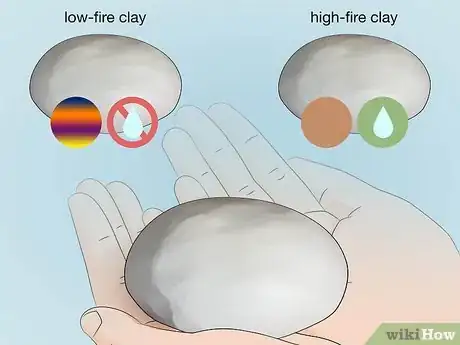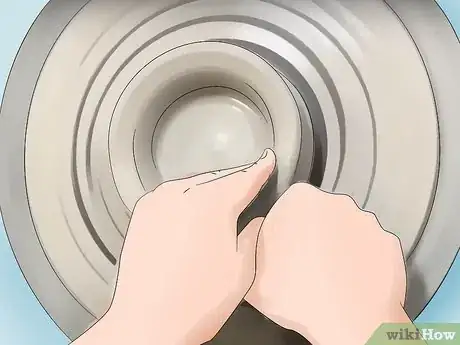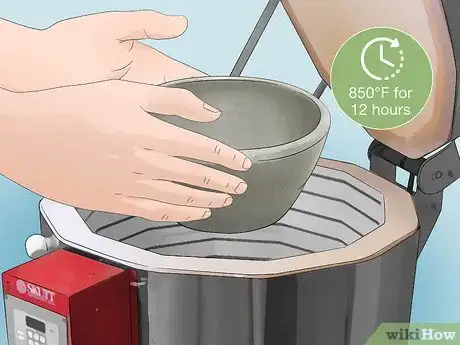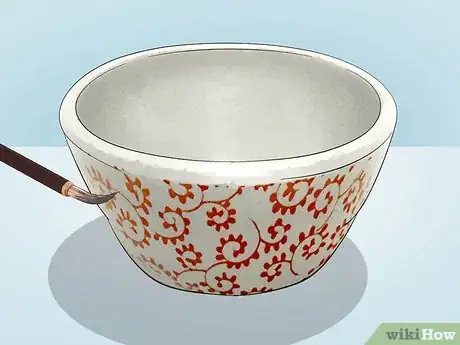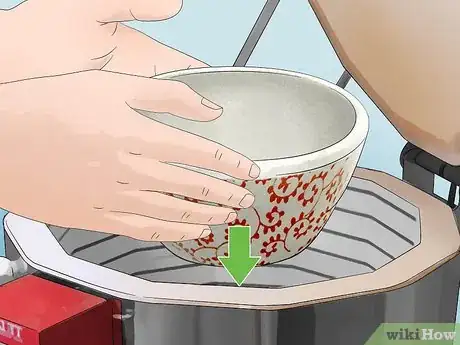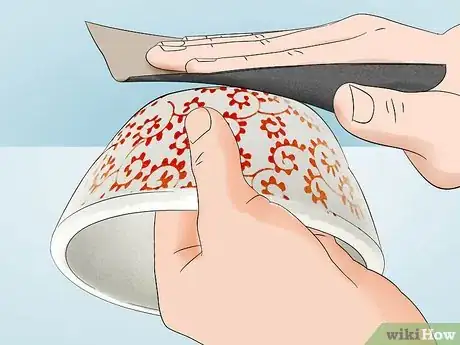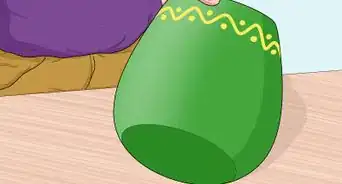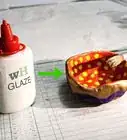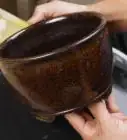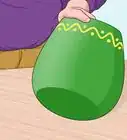This article was co-authored by Deanna Ranlett. Deanna Ranlett is a Pottery and Ceramics Professional and the Owner of Mudfire Inc. in Decatur, Georgia. With more than 22 years of experience in the ceramics industry and eight years of experience owning a studio, they specialize in glaze formulation, firing ceramic and pottery pieces, general clay projects, and screen printing for ceramics. Deanna holds a BFA in Ceramic Arts and Ceramics from Georgia State University.
There are 7 references cited in this article, which can be found at the bottom of the page.
This article has been viewed 291,418 times.
So you've got a set of plates, bowls, and cups that you love -- but it's even better to make your own in a process we call "pottery." Finding a cute set at the store is nice, but being able to put your own twist on objects you use every day is priceless - and easier than you'd think!
Steps
Making Your Object
-
1Pick your clay. To pick the right clay for your project, determine where you will be firing and check what the cone firing temperature will be. Both low-fire and high-fire commercial glazes are available in a wide array of colors. You might consider air dry clay, which doesn't need to be fired.[1] But it's a bit expensive, so you might want to stick to smaller creations. Alternatively, Fimo clay is baked in a regular oven and already comes in various colors which can be blended together. Otherwise, there's low-fire or high-fire clays, and they warrant different results.[2]
- Low-fire clays are great for bright colors and detailed decoration. But they're not super good in water, so if you do go for low-fire clay, get a glaze that you know will seal 'er up.
- High-fire clays aren't so great with bright colors, but they're sturdy, waterproof, and can be texturized easily. Glazes may move when fired, so detailed images could get blurred.[3]
-
2Decide which method will work best for your project. You have a few options to choose from:[4]
- Potter's wheel: Best for bowls or plates, vases or anything you need to be symmetrical and round, it takes a lot of practice to get really skillful at this.[5] It also requires a kiln and knowledge of firing and glazes. It's good for large and small objects, but again it is tough to rework if mistakes happen initially.
- Pinching by hand: Best for small objects.[6] The method is fairly straightforward: Start off with a small amount of clay that you can work with in your palms. Mold it with pressure from your thumb and index finger and keep turning it in your other palm if you want it round, and keep the "walls" even.[7] Use a damp sponge to smooth the surface.
- Coiling:[8] Best for hollow or non symmetrical objects. You can create an interesting texture or pattern by or coiling layers together. Instead of one block of clay, you simply pile or coils into a shape.[9] They adhere together with slip and create one mass.
- Slab making: Best for flat-sided objects.[10] You put the sides of the clay onto a form. Use a plastic bag so it won't stick or use a light coating of cooking oil. As it dries remove it from the original form, it will shrink and possibly crack if left draped over a bowl but it will maintain its shape.
Advertisement -
3Form away. This is up to you and your skill level. If you have a wheel, great. If you don't, there are ways around that. If you're brand new to pottery, seek out a professional or watch a few videos online; it's an art that requires skill, most definitely.
- Some clays aren't able to be molded, shaped back into a ball, and molded again. So when you make your choices, be careful -- your clay may not be too keen on giving you a second chance.
Firing Your Object
-
1Place the pottery in an electric kiln. Raise the temperature of the kiln to 850°F (455°C) for 12 hours. This will produce "bisque" or "unglazed pottery." This initial firing removes the physical and chemical water so that the piece can be glazed without returning to mud and breaking. Ranges of temperature are referred to as "cones" in the ceramics world.[11]
- Allow the temperature to drop and remove the pottery 48 hours later after the temperature has completely cooled.
- Bisque temperature is approximately 1,850–1,950 °F (1,010–1,070 °C) for a cone 06-04 firing for bisque. Cone 6 is 2,180–2,232 °F (1,193–1,222 °C) and Cone 10 is 2,300–2,400 °F (1,260–1,320 °C).
-
2Paint your object with glaze.[12] Keep in mind that glaze will run. Cover the bottom of your pottery with wax to shield it from sticking to the kiln shelf itself. If you want more precise lines, paint with "bisque stain" and then cover with a clear glaze.[13]
- If your surface isn't smooth, use a 100 grit sandpaper or a kitchen paring knife edge to make it so. Then sponge the entire surface of the pot to remove any dust left from sanding to provide a clean surface for the glaze to adhere to.
- Glazing takes on a number of forms. You can dip, brush, sponge, or etch -- just to get the list started. Use wax to keep the bottom from getting glaze on it during firing. You can also buy glazes in liquid or dry form. If you want to be a real pro, eventually you can make your own.
-
3Reheat the pottery to melt the glaze and seal your object.[14] Depending on your clay, the size of the object, and the glaze, you may need a kiln that hits 2500° Fahrenheit (1148° C).[15]
- Overnight, warm up your kiln at very low heat. Spend two hours at low heat (an increase in temperature of no more than 200°F per hour) and then two hours at medium heat (an increase in temperature of no more than 300°F per hour). Finally, finish at high heat (an increase in temperature of 300 to 400°F per hour) until the required temperature has been reached.
-
4File down the bottom of your object. It may have rested on the bottom of the kiln in an awkward position, forcing it to lose its flat bottom. Smooth it so that it sits without wobbling on a surface such as a table or shelf.
- Add felt onto the bottom of your object if you so desire. Then, admire your finished product!
Expert Q&A
-
QuestionHow do you make a clay mug by hand?
 Deanna RanlettDeanna Ranlett is a Pottery and Ceramics Professional and the Owner of Mudfire Inc. in Decatur, Georgia. With more than 22 years of experience in the ceramics industry and eight years of experience owning a studio, they specialize in glaze formulation, firing ceramic and pottery pieces, general clay projects, and screen printing for ceramics. Deanna holds a BFA in Ceramic Arts and Ceramics from Georgia State University.
Deanna RanlettDeanna Ranlett is a Pottery and Ceramics Professional and the Owner of Mudfire Inc. in Decatur, Georgia. With more than 22 years of experience in the ceramics industry and eight years of experience owning a studio, they specialize in glaze formulation, firing ceramic and pottery pieces, general clay projects, and screen printing for ceramics. Deanna holds a BFA in Ceramic Arts and Ceramics from Georgia State University.
Pottery & Ceramics Professional The slab method is ideal if you're working at home without any studio equipment. You can use just about anything as a template for your slab, like a tumbler or paper cup. A pottery wheel is another great option, if you have one.
The slab method is ideal if you're working at home without any studio equipment. You can use just about anything as a template for your slab, like a tumbler or paper cup. A pottery wheel is another great option, if you have one. -
QuestionWhich method is the best method of making pottery?
 Deanna RanlettDeanna Ranlett is a Pottery and Ceramics Professional and the Owner of Mudfire Inc. in Decatur, Georgia. With more than 22 years of experience in the ceramics industry and eight years of experience owning a studio, they specialize in glaze formulation, firing ceramic and pottery pieces, general clay projects, and screen printing for ceramics. Deanna holds a BFA in Ceramic Arts and Ceramics from Georgia State University.
Deanna RanlettDeanna Ranlett is a Pottery and Ceramics Professional and the Owner of Mudfire Inc. in Decatur, Georgia. With more than 22 years of experience in the ceramics industry and eight years of experience owning a studio, they specialize in glaze formulation, firing ceramic and pottery pieces, general clay projects, and screen printing for ceramics. Deanna holds a BFA in Ceramic Arts and Ceramics from Georgia State University.
Pottery & Ceramics Professional It really depends on your project! A project worked in the round is best suited for a pottery wheel, while slab-building is better for a uniform project. If you're sculpting a figure or face, working with coils might be best.
It really depends on your project! A project worked in the round is best suited for a pottery wheel, while slab-building is better for a uniform project. If you're sculpting a figure or face, working with coils might be best. -
QuestionWhat is the easiest way to make pottery?
 Deanna RanlettDeanna Ranlett is a Pottery and Ceramics Professional and the Owner of Mudfire Inc. in Decatur, Georgia. With more than 22 years of experience in the ceramics industry and eight years of experience owning a studio, they specialize in glaze formulation, firing ceramic and pottery pieces, general clay projects, and screen printing for ceramics. Deanna holds a BFA in Ceramic Arts and Ceramics from Georgia State University.
Deanna RanlettDeanna Ranlett is a Pottery and Ceramics Professional and the Owner of Mudfire Inc. in Decatur, Georgia. With more than 22 years of experience in the ceramics industry and eight years of experience owning a studio, they specialize in glaze formulation, firing ceramic and pottery pieces, general clay projects, and screen printing for ceramics. Deanna holds a BFA in Ceramic Arts and Ceramics from Georgia State University.
Pottery & Ceramics Professional Slab building is one of the easiest pottery methods to learn! You're essentially working with a sheet of clay, which is similar to working with cookie dough, pie dough, or playdough in a flat form.
Slab building is one of the easiest pottery methods to learn! You're essentially working with a sheet of clay, which is similar to working with cookie dough, pie dough, or playdough in a flat form.
References
- ↑ Natasha Dikareva, MFA. Ceramics & Sculpting Instructor. Expert Interview. 5 May 2020.
- ↑ https://kilnarts.org/education/ceramic-pottery/the-basics-of-clay/types-of-clay/
- ↑ http://www.bigceramicstore.com/info/ceramics/tips/tip13_getting_started.html
- ↑ https://www.artsy.net/article/artsy-editorial-5-ceramic-techniques-you-need-to-know
- ↑ Deanna Ranlett. Pottery & Ceramics Professional. Expert Interview. 12 November 2021.
- ↑ Deanna Ranlett. Pottery & Ceramics Professional. Expert Interview. 12 November 2021.
- ↑ Natasha Dikareva, MFA. Ceramics & Sculpting Instructor. Expert Interview. 5 May 2020.
- ↑ Deanna Ranlett. Pottery & Ceramics Professional. Expert Interview. 12 November 2021.
- ↑ Natasha Dikareva, MFA. Ceramics & Sculpting Instructor. Expert Interview. 5 May 2020.
- ↑ Deanna Ranlett. Pottery & Ceramics Professional. Expert Interview. 12 November 2021.
- ↑ http://www.howtomakepottery.com/glazing_and_firing.html
- ↑ Deanna Ranlett. Pottery & Ceramics Professional. Expert Interview. 12 November 2021.
- ↑ http://www.howtomakepottery.com/glazing_and_firing.html
- ↑ Deanna Ranlett. Pottery & Ceramics Professional. Expert Interview. 12 November 2021.
- ↑ https://ceramicartsnetwork.org/daily/firing-techniques/electric-kiln-firing/firing-clay-lowdown-ceramic-firing-process/
About This Article
If you want to make pottery, decide on which item you're going to make before choosing an appropriate clay, such as low-fire clay. If you're making a bowl or plate, use a potter's wheel to ensure it's symmetrical. However, if you're creating a smaller object, pinch the clay by hand between your thumb and forefinger to form the shape you require. When your piece is finished, place it in an electric kiln at 800 degrees F for 12 hours to remove all liquids from the clay. Finish by glazing your object. For tips on how to reheat your object to melt the glaze and file down the bottom of your object, read on!
